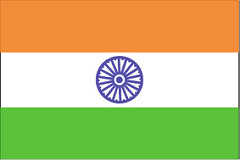India’s Republic Day, January 26 Posted by Nitya on Jan 30, 2018 in Hindi Language
This past weekend, friends and family in India enjoyed a long weekend in observance of India’s Republic Day भारतीय गणतंत्र दिवस (Bharatiya GaNatantra Divas), which is celebrated on January 26 each year. It marks the day that the Constitution of India came into effect (January 26, 1950), thus cementing India’s transition into an independent republic after it’s independence from British rule on August 15, 1947, which is observed as India’s Independence Day or स्वतंत्रता दिवस (Swatantrataa Divas).
Both days evoke patriotism देशप्रेम (deshprem) and patriotic songs can be heard on television as well as blaring on loudspeakers in neighborhoods. Both days also remember fallen soldiers सिपाही/जवान (sipaahi / jawaan) and celebrate those who are still in active duty in the nation’s armed forces.
The Indian Armed Forces भारतीय सशस्त्र सनाएँ (Bharatiya Sashastra Senaaen) comprises the Indian Air Force भारतीय वायु सेना (Bharatiya Vaayu Sena), the Indian Army भारतीय थलसेना (Bharatiya Thal Sena) and the Indian Navy भारतीय नौ सेना (Bharatiya Nau Sena).
India’s national anthem is Jana Gana Mana जन गण मन which was written and composed by Bengali poet Rabindranath Tagore. Another song that is synonymous with India’s independence and freedom struggle is Vande Mataram वन्दे मातरम् which was written by Bankim Chandra Chattopadhyaya in the late 1800s and adopted as India’s national song in October 1937 by the Congress Working Committee. It was made into a song with music set by Rabindranath Tagore. Vande Mataram वन्दे मातरम् translates to “I salute you, mother,” where mother refers to India or the motherland.
Although the original song is a beautiful composition in its own right, the version that has always resonated in my memory is this one below from the movie Anand Math, and beautifully sung by Lata Mangeshkar. It is a scene that depicts the patriotic fervor and resistance that eventually led to a free आज़ाद(aazaad) India.
BLOG VOCABULARY
| भारतीय गणतंत्र दिवस | Bharatiya Ganatantra Divas | India's Republic Day |
| भारतीय स्वतंत्रता दिवस | Bharatiya Swatantrataa Divas | India's Independence Day |
| दिवस | divas | day |
| भारतीय | Bharatiya | Indian |
| गणतंत्र | ganatantra | republic |
| स्वतंत्रता | swatantrataa | freedom |
| देशप्रेम | desh prem | patriotism/love for the country |
| सिपाही/जवान | sipaahi/jawaan | soldier |
| भारतीय सशस्त्र सनाएँ | Bharatiya Sashastra Senaaen | Indian Armed Forces |
| भारतीय वायु सेना | Bharatiya Vayu Sena | Indian Air Force |
| भारतीय थलसेना | Bharatiya Thal Sena | Indian Army |
| भारतीय नौ सेना | Bharatiya Nau Sena | Indian Navy |
| आज़ाद | aazaad | free |
| जंग | jung | war |
| सुरक्षा | suraksha | protection |
| सरहद | sarhad | border |
| शस्त्र | shastra | weapons |

Keep learning Hindi with us!
Build vocabulary, practice pronunciation, and more with Transparent Language Online. Available anytime, anywhere, on any device.
Share this:




